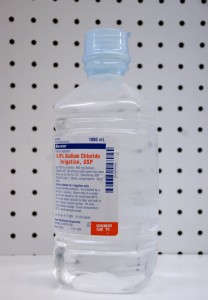Chemical preparation refers to use of an irrigant or combination during and after biomechanical preparation of root canal.
Earlier in 1940 water was commonly used irrigant since it was readily available ,inexpensive and provided a lubricating effect like all non viscous fluids.
Egs: [accg to Grossman]
a stream of hot water [140-1760 F]
physiologic saline
30% solution of urea
urea peroxide solution in glycerin
a solution of chloramine
Hydrogen peroxide
sodium hypochlorite
sodium hypochlorite and EDTA
chlorhexidine and
irrigants containing metronidazole are also used.
Functions of an irrigant
Irrigants perform important physical and biologic functions during endodontic therapy.
1.Antimicrobial property
Naocl is the most effective agent at a concentration of 5.2% ,spores of Bacillus subtilis were destroyed on 1 min exposure.
2.Dissolution of necrotic tissue.
The irrigants loosen debris,pulp tissue and micro organisms from the irregular dentin walls so that they can be removed from the canal
3) Aid in the debridement of canals system
4) Lubrication property.
5) Chelation: Certain irrigant like EDTA aid in negotiating of narrow and calcified canals by substituting Ca ions and soluble salts
6) Certain irrigants can cause a bleaching action.
Ideal requisites for an irrigant include:
Low toxicity- It should be biocompatible i.e non injurious to periapical tissues or intra oral tissues
Low surface as this will promote its wetting
tension: capacity
Low neutralizability: Its action should not get nullified by canal components so as to prolong enhance and retain its effectiveness
Easy availability
Cost effective
Convenient for usage
Good shelf life
Easy storage etc.
 Classification grouped into:
I Acids and chelating agents
II Proteolytic enzymes – Eg: Streptokinase for their
Streptodornase tissue solvency
property
III Alkaline solutions: Na dioxide, NaoH, KOH, Urea, NaOCl
IV Oxidizing agents: 3% H2O2
Acids and chelating agents:
Softens dentin and canal preparation was made easier.
E.g.: 30% HCl
Late 1940
50% H2 SO4
Chelating agents 1970
Softened dentin
biologically acceptable
E.g.: EDTA 17% [ethylene diamine tetra acetic acid]
REDTA [EDTA buffered with NaOH in aqueous vehicle]
RC prep
Citric Acid.
EDTAC
Alkaline solution: Sodium Hypochlorite
Effective concentration – 2.6 -5.2% to use as an organic solvent in the r.c
Naocl is a reducing agent.
It is a clear straw colored proteolytic solution containing 5% of available chlorine.
Solution should be kept in a cool place, away from sunlight
– The solution is inexpensive and has a long shelf life.
– It is highly alkaline with a pH of 11-11.5.
Properties may be enhanced by increasing temperature of solution
Effectiveness is increased when used with ultrasonic energy
Dilution decreases antimicrobial property, tissue dissolution property and debridement property.
Commercially available as household bleaching
solutions E.g Clorox,purex, linco 5.25%
5.25% of Naocl can dissolve pulp tissue completely in 20 mins to 2 hrs
Mechanism of action
The antimicrobial action of Naocl takes place via 2 modes.
The chlorine ion: when Naocl comes in contact with organic debris / pulp tissue, hypochlorous acid is formed. The latter is able to penetrate the bacterial cell, oxidise the sulfhydryl groups of the bacterial enzymes and disrupts the metabolism which eventually leads to their death
the 2nd mode is via its alkalinity Naocl has a high pH of 11-11.5 which is effective in eliminating anaerobes which need an acidic environment to thrive.
Functions:
– Excellent Tissue solvent property
Lubrication during instrumentation of canal.
Antimicrobial property
It exerts bleaching action on discolored teeth
Drawbacks:-
It causes mild to severe cellular damage and toxicity if extruded beyond the apex
It has high surface tension which decreases its dentin wetting capacity
It is caustic can cause inflammation of gingival tissue
It has an unpleasant taste,
It tends to corrode equipment
It can bleach clothes if split
Hydrogen peroxide – concn – 3%
It is an oxidizing agent used in a concentration of 3% .
It is almost always used in conjunction with NaOCl
The alternate use of 3% H2O2 and 5.2% Naocl produces
transient but energetic, effervescence which can mechanically force debris out of the canal
release of nascent oxygen destroys anaerobic organisms.
certain amount of bleaching also occurs
Advantages :
1) Effervescent reaction mechanically bubbles and pushes debris out of the canal
The solvent action of Naocl on the organic debris of pulp tissue
Disinfecting and bleaching actions of both solutions.
– H2O2 can react with pulp debris and blood to form gas causing continuous pain. so Naocl should be used as last irrigant
Glyoxide:
It is carbamide peroxide in anhydrous glycerol base .
Glycerol is added to prevent decomposition and to utilize the slippery effect of the compound.
It is better tolerated by the tissues than is Naocl .
It has solvent property and is more germicidal than H2O2
The best use of glyoxide is in narrow and or curved canals,utilizing the slippery effect of the glycerol.
